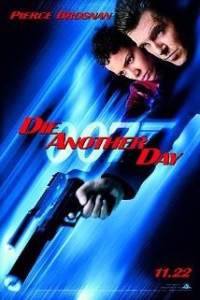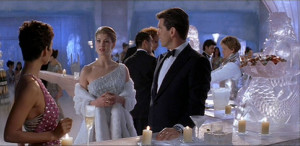 It’s funny to me that the central visual in the marketing campaign for the Bond film that put the long running series on ice was… ice. If that’s not irony I don’t know what is. “But wait,” says the year 2002, “this is supposed to be a grittier Bond with more realism and higher stakes.” That’s a good thought, and one that would eventually work four years later with a different Bond. Unfortunately for this movie though, it landed squarely in the crosshairs of an audience experiencing not just Bond fatigue, but hero fatigue.
It’s funny to me that the central visual in the marketing campaign for the Bond film that put the long running series on ice was… ice. If that’s not irony I don’t know what is. “But wait,” says the year 2002, “this is supposed to be a grittier Bond with more realism and higher stakes.” That’s a good thought, and one that would eventually work four years later with a different Bond. Unfortunately for this movie though, it landed squarely in the crosshairs of an audience experiencing not just Bond fatigue, but hero fatigue.
Bond tortured. Bond with a beard and long hair! Michael Madsen with a cameo appearance! This must be the darker, edgier Bond we need, right? Close, but oh so far away. The first clue that this approach wasn’t going to work in this film should have been the night-surfing Bond in the opening sequence. Whereas in Goldeneye, Bond started off by bungee jumping down a steep, intimidating dam, here he is coasting effortlessly on a surfboard with hidden C4 inside it. Really?
Despite the start, the film is actually pretty even for a modern Bond film. That is, until the final quarter of the movie. I’m not sure a Bond film has ever fallen off a figurative cliff so fast. I mean, a car chase on ice is cool I guess. But it’s all so meaningless and without teeth. And parasailing on a makeshift surfboard atop a tidal wave? Nope.
While the themes of the movie are mostly thrown about thinly for sake of action sequences, this is a film about identity. Whether hiding behind genetic modification or behind the veil of action heroism, the film seems to want to talk about who villains and heroes really are; it just kind of forgets to do that. Imagery of hot and cold is throughout the movie- the fire and ice girls in the opening credits, the Havana to Iceland global trek. Like everything else, it doesn’t really go anywhere, but it’s an easy metaphor for where the Bond character was at the time of the film and in the film itself. He was suave and heroic, but also cheesy and cliché. It was, however, the end of an old era and the beginning of exploration that gave us the new era.
Gustav Graves: “It’s only by being on the edge that we know who we really are under the skin.”
 The only real attempt in the script to address any sort of thematic element comes across squarely on the nose and completely obvious. But this notion is exactly what the producers and audiences were wanting from Bond. Putting a little edge on Bond would indeed give us a better sense of who he is. Within all the flash and charm, it’s easy to forget that Bond is a killing machine. Pierce Brosnan wouldn’t get a chance at this type of Bond, but it’s an indication of the shift in our entertainment desires post 9-11.
The only real attempt in the script to address any sort of thematic element comes across squarely on the nose and completely obvious. But this notion is exactly what the producers and audiences were wanting from Bond. Putting a little edge on Bond would indeed give us a better sense of who he is. Within all the flash and charm, it’s easy to forget that Bond is a killing machine. Pierce Brosnan wouldn’t get a chance at this type of Bond, but it’s an indication of the shift in our entertainment desires post 9-11.
This film was shot just a few months after the cultural shifting tragedy of September 11th, and it represents a Bond stuck in a time before our entertainment reflected a bit more cynicism. Bond will never be the anti-hero we now see everywhere, but that doesn’t mean he can’t still be the hero we root for. We just want James Bond to bleed, lose control of his anger, make mistakes. In a word, we want him to be human. Even our in-humans like Thor or Superman are imperfect these days.
You can’t have a human hero be impervious to danger because none of us are impervious to it in reality. We are living in a cultural climate where danger seems more and more ever present. With our entertainment we want our cake and to eat it too. This is a series that embraces its nostalgia full on. There’s nothing wrong with that. Vintage is popular, and likely always will be. But we need to see cracks on the surface. We want to hold onto that nostalgia, but with purpose. So if we’re going to walk across the ice, we want to feel like we might fall beneath it at any moment. Bond will always live to ‘die another day’. But in part 2, I’ll review what it looks like when we get our wish- a Bond that seems like he might not.

1 comment